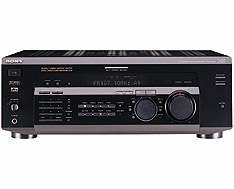 |


TechnoFILE is copyright and a registered trademark © ® of
Pandemonium Productions.
All rights reserved.
E-mail us Here!

Making a Sound InvestmentBy Jim Bray Part Two: The Components We Used Part Four: Buying a Projection TV Part Six: Buying a Receiver Part Eight: More on Buying Speakers The TV may be a home theater's heart, but the audio system is its soul. After all, what's the point of watching really neat explosions if they don't shake the house? Okay, if you live in a thin-walled apartment - or just don't like a lot of noise - you may disagree, but in the grand scheme of things your home theater's audio quality is as important as its video. Besides speakers, which I'll cover in separate columns, a home theater audio system is made up of three basic units: the amplifier, the preamplifier/control unit and the surround processor. If you're really going for the gusto you can get them separately (possibly via a second mortgage), but most people compromise dollars, shelf space, and performance by choosing the all-in-one route of an audio/video receiver. These are boxes that contain all the abovementioned components, plus a radio tuner and, normally, a remote control. You might say that receivers are nothing if not flexible. Purists say receivers compromise the quality, and they're right - but most "real world" people are well served by them. Audio/video receivers can be had for well under $300, but you'll probably have to settle for Dolby Pro Logic rather than Dolby Digital or DTS surround sound. If that doesn't bother you, don't let yourself be talked into anything more esoteric. Dolby Pro Logic served the world well for the better part of twenty years. It gives you a single, "monaural" surround track from the rear speakers. Dolby Digital (also known as AC-3) and DTS up the ante by offering full range stereo surround and once you're hooked you won't want Pro Logic. Some people say DTS is better than Dolby Digital. I have both systems in my home theater and the chief difference I've been able to discern, from my decidedly unscientific tests, is that DTS has a nifty audio/video logo at the beginning of the DTS-encoded discs. On the other hand, virtually every DVD comes with Dolby Digital audio, while DTS is available on far fewer discs so far. Most current A/V receivers and DVD players that offer Dolby Digital also include DTS, however, so this isn't a big deal any more. Some low end receivers compromise between offering only Dolby Pro Logic and the "5.1 channels" (the three front and two rear channels, plus a subwoofer) of AC-3 and DTS. They include all the inputs you need to accept the 5.1 channel information, but without the decoding circuits. To enter the digital domain you'll need to patch in a video source (like a DVD player) that has built in decoders so, while you may save a few bucks on the receiver, you'll spend extra on the source. Receivers with the Dolby Digital/DTS stuff built in are available for under $400 anyway, so it isn't much of a hardship going for the extra gusto. Many receivers also offer a sometimes-dizzying array of fake surround sound modes. These are kind of neat, but in my experience I've rarely used them. Make sure your chosen receiver has enough inputs and outputs to handle all of your other toys, like your TV, VCR, DVD player, Satellite, phono, etc. Most mainstream units should, though phono inputs are becoming somewhat rare. Remember, too, that power ratings can be misleading. Many stores try to impress you with "fake" power ratings (for instance, 200 watts), when the receiver in question actually pumps out 40 watts into each of the five main channels. Forty watts per channel may be plenty, but don't be fooled into thinking you're getting more than you really are. Unless you listen to a lot of radio, don't be too concerned by the tuner section and/or its number of station presets. Many receivers offer something like 30 presets; this sounds great, but can you think of 30 radio stations you really want to store into memory? Don't forget to try the unit's remote control! This is the piece you'll use more than anything, so make sure you're comfortable with it. Many will work multiple components, and others are programmable to operate different brands of equipment as well. In the end, don't sweat it excessively. Look for the features and flexibility you want, and a sound quality you like. If you use your head, you should have many years of enjoyment from your "audio control center." Jim Bray's technology columns are distributed by the TechnoFILE and Mochila Syndicates. Copyright Jim Bray.
|
|
|
| Support TechnoFile via Paypal |
| TechnoFILE's
E-letter We're pleased to offer our FREE private, subscription-based private E-mail service. It's the "no brainer" way to keep informed. Our Privacy Policy |